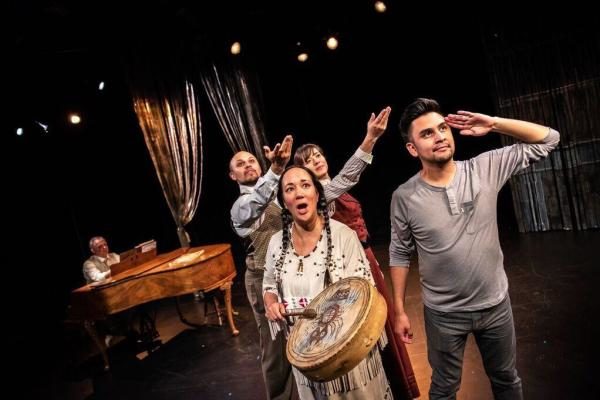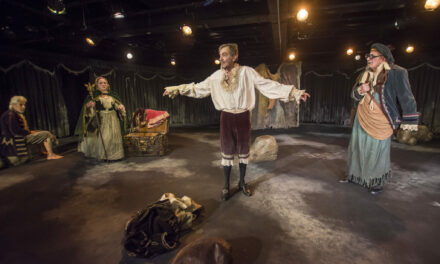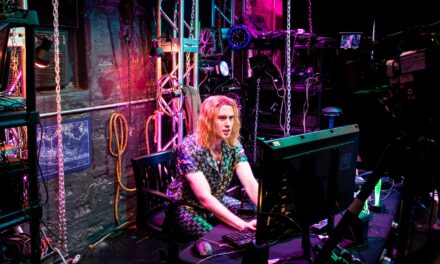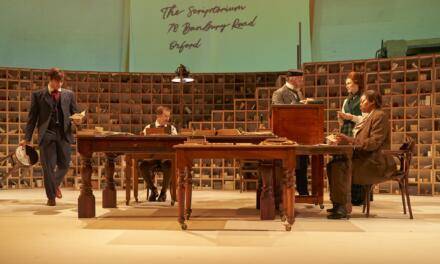After attending a rehearsal and speaking with playwright Jani Lauzon and director Marjorie Chan, Robyn Grant-Moran reviews I Call Myself Princess, a Cahoots Theatre/Paper Canoe Projects production in association with Native Earth Performing Arts. This is the last of three “embedded” posts about I Call Myself Princess–click here for the first post, or here for the second. For more information on embedded criticism, click here.
The house is full and buzzing with anticipation at Aki Studio for I Call Myself Princess’ opening night. Breathing life into history while exploring it critically and with empathy is no small feat, but playwright Jani Lauzon and her team are up to the task.
Keith Barker, artistic director of Native Earth, gives one of the most thoughtful land acknowledgments I have heard over the past year, during which he laughs off his opening night jitters and tells us the sage advice an elder once gave him: if you are feeling disconnected, go outside and touch the ground. In other words, reestablish a relationship with yourself and the land. Barker then encourages us to consider what we do to tend to the land we have agreed to care for, to consider our relationship with the place many consider home.
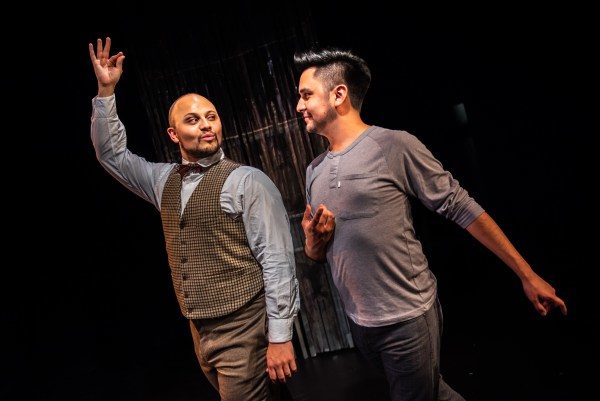
Howard J. Davis and Aaron M. Wells in I Call Myself Princess. Photo by Dahlia Katz
The cast of five is small, but the play is immense. William Morin (Aaron. M Wells), a young Metis man, leaves his life in Winnipeg to study opera in Toronto. He leaves his partner, Alex Park (Howard Davis), and the comfort provided by their relationship for a new long-distance version. Thanks to a generous scholarship, William is able to manifest his dreams, but it comes at the cost of losing connection to his homeland and his love. The nameless music school is mounting the opera Shanewis: The Robin Woman for their end of year performance; a welcome of sorts for their only Indigenous student. As William researches the opera, Tsianina Redfeather (Marion Newman) visits him and brings him into her life 100 years in the past. From being discovered as a novelty–a savage who sings like the civilized folk–through her collaborations with composer Charles Wakefield Cadman (Richard Greenblatt) and lyricist/librettist Nelle Eberhart (Courtney Ch’ng Lancaster), and life of fame, she guides William with patience, compassion, and occasional frustration as he unravels her history–with William himself unraveling in the process.
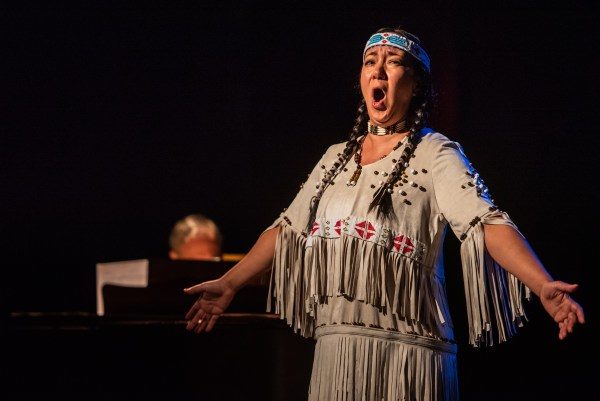
Marion Newman in I Call Myself Princess. Photo by Dahlia Katz.
The set design hasn’t changed much from the previous week’s rehearsal. Lights and a fireplace have been added, changing the studio theatre into a room in an old house that hasn’t seen traffic from previous tenants for decades. I reflect back on the previous day’s interview, when Marjorie Chan talked about the layering of the play, that she at times had to balance four realities at once. Bodies partially obscured by curtains appear and disappear to hint at those realities. An original composition by Jerod Impichchaachaaha’ Tate (music director) haunts the space moments before William enters.
Much of the playful experimentation that I witnessed has made its way into the first scenes. Tsianina Redfeather (Marion Newman) has new moccasins (Jani Lauzon finished them and they look lovely!) What a difference a day can make.
In William’s world, music is more than just the thread that connects the material and spirit worlds. It connects everyone; however, it is not a universal language. It provides a connection to the past, but it’s also a point of conflict–William has to learn that nothing in history is as simple as he perceives with his luxury of hindsight. In the present, he is armed with access to information that Redfeather did not have; he has online libraries and encyclopedias, social media where Indigenous people can share knowledge and check in with one another. Redfeather brings William into her world without technology and immediate communication, where he learns about her through singing her songs and the history she shares with him.
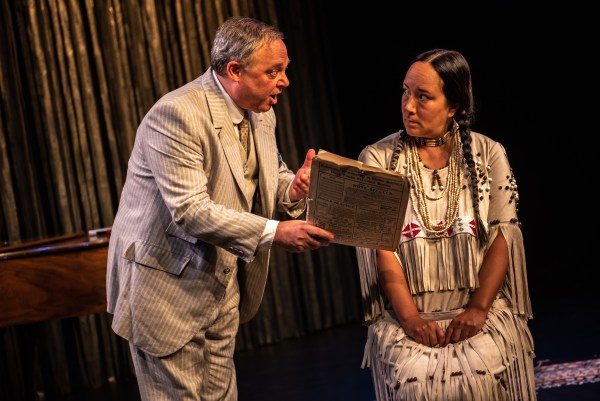
Richard Greenblatt and Marion Newman in I Call Myself Princess. Photo by Dahlia Katz.
In Redfeather’s world, the relationship between herself, Cadman and Eberhart, and their music is complex. A contemporary audience must remember that this was a time (albeit not significantly different from today) when most people didn’t understand that different tribes and nations had different customs, cultures, and languages. Chickasaw, Osage, Cherokee, Ojibway–all interchangeable to a settler/colonial eye. Artists like Redfeather had to balance keeping their traditions their own while doing their best to keep Indigenous cultures alive. That couldn’t have been easy for people who feared their nations were dying out. It’s easy to laugh about the music, or be angry, but operas like Shanewis were borne of the efforts of a number of people doing the best they could with what they had. Redfeather draws William into the laughable powwow scene from Shanewis; something that seems so absurd and insensitive on paper becomes sympathetic. Flawed and insensitive they may be, but perhaps the Indianists of the 20th century were indeed trying to Indigenize opera with the best of intentions. 100 years later and history is repeating.
Returning to I Call Myself Princess, the entire ensemble does a superb job with the music. Everyone has had musical training, but operatic singing is akin to Olympic power lifting in the singing world. Newman has a lovely mezzo voice, and is always a joy to hear even when it involves songs inviting salmon to jump into her arms (and other absurd sounding text). Aaron M. Wells sings a touching Du Bist Die Ruh (F. Schubert), a difficult song with many long sustained phrases. He sounds perfect for his part as a young tenor in an opera program–so much so that he almost left me nostalgic for noontime recitals and masterclasses. Together with Davis, Greenblatt, and Lancaster, their unique and distinct voices manage to fit together perfectly, knowing when to blend and when to stand out.
It is absolutely thrilling to see something that speaks so specifically to me staged. More than that, however, I Call Myself Princess is powerful because it tells a story about Indigenous people navigating a colonial/settler space; it’s by an Indigenous writer with Indigenous actors playing Indigenous characters. This play should not feel like an act of resistance in 2018, but with productions like SLAV, Kanata, and others happening, it does.
In my first piece, I stated that the ancestors are escalating and Jani Lauzon is a skilled and gifted conduit. I stand by that. But I would like to add that the same also needs to be said not only for Marjorie Chan, but for every artist involved in this production.
This article first appeared in Alt Theatre on October 21, 2018, and has been reposted with permission.
This post was written by the author in their personal capacity.The opinions expressed in this article are the author’s own and do not reflect the view of The Theatre Times, their staff or collaborators.
This post was written by Robyn Grant-Moran.
The views expressed here belong to the author and do not necessarily reflect our views and opinions.

